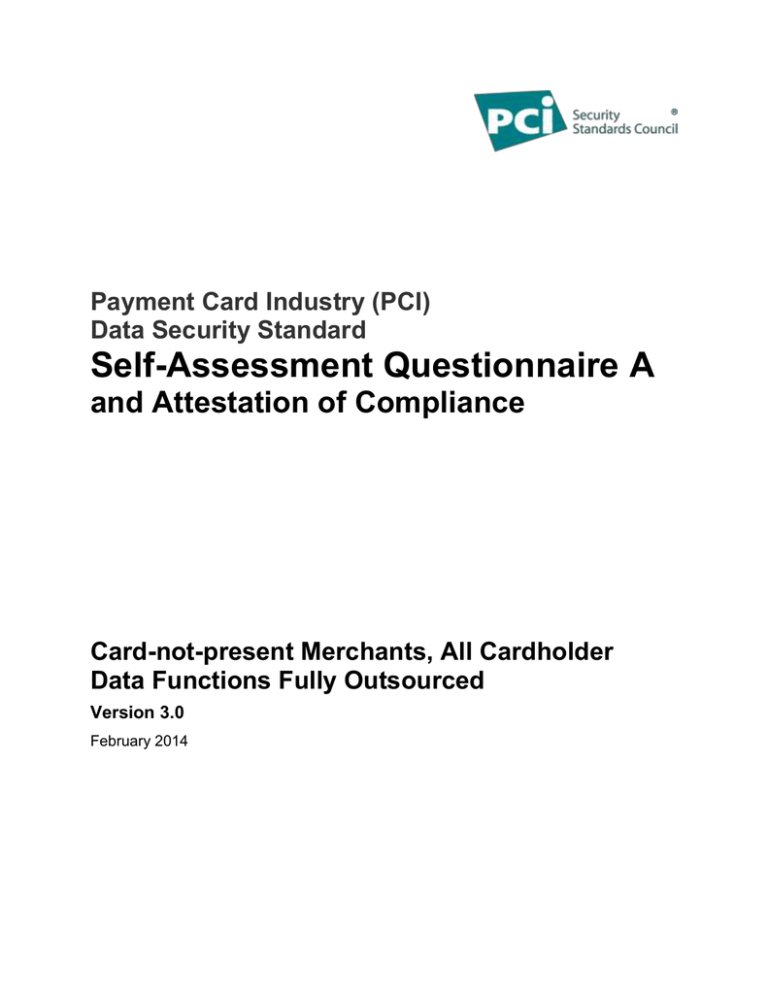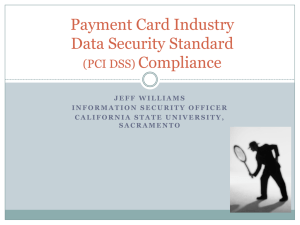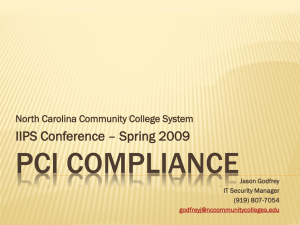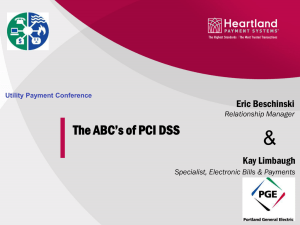
Payment Card Industry (PCI)
Data Security Standard
Self-Assessment Questionnaire A
and Attestation of Compliance
Card-not-present Merchants, All Cardholder
Data Functions Fully Outsourced
Version 3.0
February 2014
Document Changes
Date
Version
Description
October 2008
1.2
To align content with new PCI DSS v1.2 and to implement minor
changes noted since original v1.1.
October 2010
2.0
To align content with new PCI DSS v2.0 requirements and testing
procedures.
February 2014
3.0
To align content with PCI DSS v3.0 requirements and testing
procedures and incorporate additional response options.
PCI DSS SAQ A, v3.0
© 2006-2014 PCI Security Standards Council, LLC. All Rights Reserved.
February 2014
Page i
Table of Contents
Document Changes .................................................................................................................. i
Before You Begin .....................................................................................................................iii
PCI DSS Self-Assessment Completion Steps ...................................................................................... iii
Understanding the Self-Assessment Questionnaire ........................................................................... iv
Expected Testing ................................................................................................................................... iv
Completing the Self-Assessment Questionnaire ................................................................................. iv
Guidance for Non-Applicability of Certain, Specific Requirements .................................................... v
Legal Exception
.................................................................................................................................... v
Section 1: Assessment Information ..................................................................................... 1
Section 2: Self-Assessment Questionnaire A...................................................................... 4
Requirement 9:
Restrict physical access to cardholder data ............................................................... 4
Maintain an Information Security Policy ................................................................................................ 6
Requirement 12: Maintain a policy that addresses information security for all personnel ..................... 6
Appendix A: Additional PCI DSS Requirements for Shared Hosting Providers ............................... 8
Appendix B: Compensating Controls Worksheet ................................................................................ 9
Appendix C: Explanation of Non-Applicability................................................................................... 10
Section 3: Validation and Attestation Details .....................................................................11
PCI DSS SAQ A, v3.0
© 2006-2014 PCI Security Standards Council, LLC. All Rights Reserved.
February 2014
Page ii
Before You Begin
SAQ A has been developed to address requirements applicable to merchants whose cardholder data
functions are completely outsourced to validated third parties, where the merchant retains only paper
reports or receipts with cardholder data.
SAQ A merchants may be either e-commerce or mail/telephone-order merchants (card-not-present), and
do not store, process, or transmit any cardholder data in electronic format on their systems or premises.
SAQ A merchants confirm that, for this payment channel:
Your company accepts only card-not-present (e-commerce or mail/telephone-order) transactions;
All payment acceptance and processing are entirely outsourced to PCI DSS validated third-party
service providers;
Your company has no direct control of the manner in which cardholder data is captured, processed,
transmitted, or stored;
Your company does not electronically store, process, or transmit any cardholder data on your
systems or premises, but relies entirely on a third party(s) to handle all these functions;
Your company has confirmed that all third party(s) handling acceptance, storage, processing,
and/or transmission of cardholder data are PCI DSS compliant; and
Your company retains only paper reports or receipts with cardholder data, and these documents
are not received electronically.
Additionally, for e-commerce channels:
The entirety of all payment pages delivered to the consumer’s browser originates directly from a
third-party PCI DSS validated service provider(s).
This SAQ is not applicable to face-to-face channels.
This shortened version of the SAQ includes questions that apply to a specific type of small merchant
environment, as defined in the above eligibility criteria. If there are PCI DSS requirements applicable to
your environment that are not covered in this SAQ, it may be an indication that this SAQ is not suitable for
your environment. Additionally, you must still comply with all applicable PCI DSS requirements in order to
be PCI DSS compliant.
PCI DSS Self-Assessment Completion Steps
1. Identify the applicable SAQ for your environment – refer to the Self-Assessment Questionnaire
Instructions and Guidelines document on PCI SSC website for information.
2. Confirm that your environment is properly scoped and meets the eligibility criteria for the SAQ you
are using (as defined in Part 2g of the Attestation of Compliance).
3. Assess your environment for compliance with applicable PCI DSS requirements.
4. Complete all sections of this document:
Section 1 (Part 1 & 2 of the AOC) – Assessment Information and Executive Summary.
Section 2 – PCI DSS Self-Assessment Questionnaire (SAQ A)
Section 3 (Parts 3 & 4 of the AOC) – Validation and Attestation Details and Action Plan for
Non-Compliant Requirements (if applicable)
5. Submit the SAQ and Attestation of Compliance, along with any other requested documentation—
such as ASV scan reports—to your acquirer, payment brand or other requester.
PCI DSS SAQ A, v3.0
© 2006-2014 PCI Security Standards Council, LLC. All Rights Reserved.
February 2014
Page iii
Understanding the Self-Assessment Questionnaire
The questions contained in the “PCI DSS Question” column in this self-assessment questionnaire are
based on the requirements in the PCI DSS.
Additional resources that provide guidance on PCI DSS requirements and how to complete the selfassessment questionnaire have been provided to assist with the assessment process. An overview of
some of these resources is provided below:
Document
Includes:
PCI DSS
Guidance on Scoping
(PCI Data Security Standard
Requirements and Security Assessment
Procedures)
Guidance on the intent of all PCI DSS Requirements
Details of testing procedures
Guidance on Compensating Controls
SAQ Instructions and Guidelines
documents
Information about all SAQs and their eligibility criteria
How to determine which SAQ is right for your
organization
PCI DSS and PA-DSS Glossary of
Terms, Abbreviations, and Acronyms
Descriptions and definitions of terms used in the PCI
DSS and self-assessment questionnaires
These and other resources can be found on the PCI SSC website (www.pcisecuritystandards.org).
Organizations are encouraged to review the PCI DSS and other supporting documents before beginning
an assessment.
Expected Testing
The instructions provided in the “Expected Testing” column are based on the testing procedures in the
PCI DSS, and provide a high-level description of the types of testing activities that should be performed in
order to verify that a requirement has been met. Full details of testing procedures for each requirement
can be found in the PCI DSS.
Completing the Self-Assessment Questionnaire
For each question, there is a choice of responses to indicate your company’s status regarding that
requirement. Only one response should be selected for each question.
A description of the meaning for each response is provided in the table below:
Response
Yes
Yes with CCW
(Compensating
Control Worksheet)
When to use this response:
The expected testing has been performed, and all elements of the
requirement have been met as stated.
The expected testing has been performed, and the requirement has
been met with the assistance of a compensating control.
All responses in this column require completion of a Compensating
Control Worksheet (CCW) in Appendix B of the SAQ.
Information on the use of compensating controls and guidance on how
to complete the worksheet is provided in the PCI DSS.
PCI DSS SAQ A, v3.0
© 2006-2014 PCI Security Standards Council, LLC. All Rights Reserved.
February 2014
Page iv
Response
When to use this response:
No
Some or all elements of the requirement have not been met, or are in
the process of being implemented, or require further testing before it will
be known if they are in place.
N/A
The requirement does not apply to the organization’s environment. (See
Guidance for Non-Applicability of Certain, Specific Requirements below
for examples.)
(Not Applicable)
All responses in this column require a supporting explanation in
Appendix C of the SAQ.
Guidance for Non-Applicability of Certain, Specific Requirements
If any requirements are deemed not applicable to your environment, select the “N/A” option for that
specific requirement, and complete the “Explanation of Non-Applicability” worksheet in Appendix C for
each “N/A” entry.
Legal Exception
If your organization is subject to a legal restriction that prevents the organization from meeting a PCI DSS
requirement, check the “No” column for that requirement and complete the relevant attestation in Part 3.
PCI DSS SAQ A, v3.0
© 2006-2014 PCI Security Standards Council, LLC. All Rights Reserved.
February 2014
Page v
Section 1: Assessment Information
Instructions for Submission
This document must be completed as a declaration of the results of the merchant’s self-assessment with the
Payment Card Industry Data Security Standard Requirements and Security Assessment Procedures (PCI
DSS). Complete all sections: The merchant is responsible for ensuring that each section is completed by the
relevant parties, as applicable. Contact acquirer (merchant bank) or the payment brands to determine reporting
and submission procedures.
Part 1. Merchant and Qualified Security Assessor Information
Part 1a. Merchant Organization Information
Company Name:
DBA (doing
business as):
Contact Name:
Title:
ISA Name(s) (if applicable):
Title:
Telephone:
E-mail:
Business Address:
City:
State/Province:
Country:
Zip:
URL:
Part 1b. Qualified Security Assessor Company Information (if applicable)
Company Name:
Lead QSA Contact Name:
Title:
Telephone:
E-mail:
Business Address:
City:
State/Province:
Country:
Zip:
URL:
Part 2. Executive Summary
Part 2a. Type of Merchant Business (check all that apply)
Retailer
Telecommunication
Grocery and Supermarkets
Petroleum
E-Commerce
Mail order/telephone order (MOTO)
Others (please specify):
What types of payment channels does your business
serve?
Which payment channels are covered by this SAQ?
Mail order/telephone order (MOTO)
Mail order/telephone order (MOTO)
E-Commerce
E-Commerce
Card-present (face-to-face)
Card-present (face-to-face)
Note: If your organization has a payment channel or process that is not covered by this SAQ, consult your
acquirer or payment brand about validation for the other channels.
PCI DSS SAQ A, v3.0 – Section 1: Assessment Information
© 2006-2014 PCI Security Standards Council, LLC. All Rights Reserved.
February 2014
Page 1
Part 2b. Description of Payment Card Business
How and in what capacity does your business
store, process and/or transmit cardholder data?
Part 2c. Locations
List types of facilities and a summary of locations included in the PCI DSS review (for example, retail outlets,
corporate offices, data centers, call centers, etc.)
Type of facility
Location(s) of facility (city, country)
Part 2d. Payment Application
Does the organization use one or more Payment Applications?
Yes
No
Provide the following information regarding the Payment Applications your organization uses:
Payment Application
Name
Version
Number
Application
Vendor
Is application
PA-DSS Listed?
Yes
No
Yes
No
Yes
No
PA-DSS Listing Expiry
date (if applicable)
Part 2e. Description of Environment
Provide a high-level description of the environment covered by
this assessment.
For example:
• Connections into and out of the cardholder data environment
(CDE).
• Critical system components within the CDE, such as POS
devices, databases, web servers, etc., and any other
necessary payment components, as applicable.
Does your business use network segmentation to affect the scope of your PCI DSS
environment?
(Refer to “Network Segmentation” section of PCI DSS for guidance on network segmentation)
PCI DSS SAQ A, v3.0 – Section 1: Assessment Information
© 2006-2014 PCI Security Standards Council, LLC. All Rights Reserved.
Yes
No
February 2014
Page 2
Part 2f. Third-Party Service Providers
Does your company share cardholder data with any third-party service providers (for example,
gateways, payment processors, payment service providers (PSP), web-hosting companies,
airline booking agents, loyalty program agents, etc.)?
Yes
No
If Yes:
Name of service provider:
Description of services provided:
Note: Requirement 12.8 applies to all entities in this list.
Part 2g. Eligibility to Complete SAQ A
Merchant certifies eligibility to complete this shortened version of the Self-Assessment Questionnaire
because, for this payment channel:
Merchant accepts only card-not-present (e-commerce or mail/telephone-order) transactions);
All payment acceptance and processing are entirely outsourced to PCI DSS validated third-party
service providers;
Merchant has no direct control of the manner in which cardholder data is captured, processed,
transmitted, or stored;
Merchant does not electronically store, process, or transmit any cardholder data on merchant systems
or premises, but relies entirely on a third party(s) to handle all these functions;
Merchant has confirmed that all third party(s) handling acceptance, storage, processing, and/or
transmission of cardholder data are PCI DSS compliant; and
Merchant retains only paper reports or receipts with cardholder data, and these documents are not
received electronically.
Additionally, for e-commerce channels:
The entirety of all payment pages delivered to the consumer’s browser originates directly from a thirdparty PCI DSS validated service provider(s).
PCI DSS SAQ A, v3.0 – Section 1: Assessment Information
© 2006-2014 PCI Security Standards Council, LLC. All Rights Reserved.
February 2014
Page 3
Section 2: Self-Assessment Questionnaire A
Note: The following questions are numbered according to PCI DSS requirements and testing procedures, as defined in the PCI DSS
Requirements and Security Assessment Procedures document.
Self-assessment completion date:
Requirement 9:
Restrict physical access to cardholder data
Response
PCI DSS Question
Expected Testing
(Check one response for each question)
Yes
Are all media physically secured (including but not
limited to computers, removable electronic media,
paper receipts, paper reports, and faxes)?
9.5
Yes with
CCW
No
N/A
Review policies and procedures for
physically securing media
Interview personnel
For purposes of Requirement 9, “media” refers to all
paper and electronic media containing cardholder data.
(a) Is strict control maintained over the internal or
external distribution of any kind of media?
9.6
Review policies and procedures for
distribution of media
(b) Do controls include the following:
9.6.1
Is media classified so the sensitivity of the data can be
determined?
Review policies and procedures for
media classification
Interview security personnel
9.6.2
9.6.3
9.7
Is media sent by secured courier or other delivery
method that can be accurately tracked?
Interview personnel
Is management approval obtained prior to moving the
media (especially when media is distributed to
individuals)?
Interview personnel
Is strict control maintained over the storage and
accessibility of media?
Review policies and procedures
PCI DSS SAQ A, v3.0 – Section 2: Self-Assessment Questionnaire
© 2006-2014 PCI Security Standards Council, LLC. All Rights Reserved.
Examine media distribution tracking logs
and documentation
Examine media distribution tracking logs
and documentation
February 2014
Page 4
Response
PCI DSS Question
Expected Testing
(Check one response for each question)
Yes
9.8
(a) Is all media destroyed when it is no longer needed
for business or legal reasons?
Yes with
CCW
No
N/A
Review periodic media destruction
policies and procedures
(c) Is media destruction performed as follows:
9.8.1 (a) Are hardcopy materials cross-cut shredded,
incinerated, or pulped so that cardholder data
cannot be reconstructed?
Review periodic media destruction
policies and procedures
Interview personnel
Observe processes
(b) Are storage containers used for materials that
contain information to be destroyed secured to
prevent access to the contents?
PCI DSS SAQ A, v3.0 – Section 2: Self-Assessment Questionnaire
© 2006-2014 PCI Security Standards Council, LLC. All Rights Reserved.
Examine security of storage containers
February 2014
Page 5
Maintain an Information Security Policy
Requirement 12:
Maintain a policy that addresses information security for all personnel
Note: For the purposes of Requirement 12, “personnel” refers to full-time part-time employees, temporary employees and personnel, and
contractors and consultants who are “resident” on the entity’s site or otherwise have access to the company’s site cardholder data environment.
Response
PCI DSS Question
Expected Testing
(Check one response for each question)
Yes
12.8
12.8.1
Yes with
CCW
No
N/A
Are policies and procedures maintained and
implemented to manage service providers with whom
cardholder data is shared, or that could affect the
security of cardholder data, as follows:
Is a list of service providers maintained?
Review policies and procedures
Observe processes
Review list of service providers
12.8.2
Is a written agreement maintained that includes an
acknowledgement that the service providers are
responsible for the security of cardholder data the
service providers possess or otherwise store, process,
or transmit on behalf of the customer, or to the extent
that they could impact the security of the customer’s
cardholder data environment?
Observe written agreements
Review policies and procedures
Note: The exact wording of an acknowledgement will
depend on the agreement between the two parties, the
details of the service being provided, and the
responsibilities assigned to each party. The
acknowledgement does not have to include the exact
wording provided in this requirement.
12.8.3
12.8.4
Is there an established process for engaging service
providers, including proper due diligence prior to
engagement?
Observe processes
Is a program maintained to monitor service providers’
PCI DSS compliance status at least annually?
Observe processes
PCI DSS SAQ A, v3.0 – Section 2: Self-Assessment Questionnaire
© 2006-2014 PCI Security Standards Council, LLC. All Rights Reserved.
Review policies and procedures and
supporting documentation
Review policies and procedures and
supporting documentation
February 2014
Page 6
Response
PCI DSS Question
Expected Testing
(Check one response for each question)
Yes
12.8.5
Is information maintained about which PCI DSS
requirements are managed by each service provider,
and which are managed by the entity?
PCI DSS SAQ A, v3.0 – Section 2: Self-Assessment Questionnaire
© 2006-2014 PCI Security Standards Council, LLC. All Rights Reserved.
Yes with
CCW
No
N/A
Observe processes
Review policies and procedures and
supporting documentation
February 2014
Page 7
Appendix A: Additional PCI DSS Requirements for Shared Hosting
Providers
This appendix is not used for merchant assessments.
PCI DSS SAQ A, v3.0 – Section 2: Self-Assessment Questionnaire
© 2006-2014 PCI Security Standards Council, LLC. All Rights Reserved.
February 2014
Page 8
Appendix B: Compensating Controls Worksheet
Use this worksheet to define compensating controls for any requirement where “YES with CCW” was
checked.
Note: Only companies that have undertaken a risk analysis and have legitimate technological or
documented business constraints can consider the use of compensating controls to achieve compliance.
Refer to Appendices B, C, and D of PCI DSS for information about compensating controls and guidance
on how to complete this worksheet.
Requirement Number and Definition:
Information Required
1. Constraints
List constraints precluding compliance
with the original requirement.
2. Objective
Define the objective of the original
control; identify the objective met by the
compensating control.
3. Identified Risk
Identify any additional risk posed by the
lack of the original control.
4. Definition of
Compensating
Controls
Define the compensating controls and
explain how they address the objectives
of the original control and the increased
risk, if any.
5. Validation of
Compensating
Controls
Define how the compensating controls
were validated and tested.
6. Maintenance
Define process and controls in place to
maintain compensating controls.
PCI DSS SAQ A, v3.0 – Section 2: Self-Assessment Questionnaire
© 2006-2014 PCI Security Standards Council, LLC. All Rights Reserved.
Explanation
February 2014
Page 9
Appendix C: Explanation of Non-Applicability
If the “N/A” (Not Applicable) column was checked in the questionnaire, use this worksheet to explain why
the related requirement is not applicable to your organization.
Requirement
Reason Requirement is Not Applicable
3.4
Cardholder data is never stored electronically
PCI DSS SAQ A, v3.0 – Section 2: Self-Assessment Questionnaire
© 2006-2014 PCI Security Standards Council, LLC. All Rights Reserved.
February 2014
Page 10
Section 3: Validation and Attestation Details
Part 3. PCI DSS Validation
Based on the results noted in the SAQ A dated (completion date), the signatories identified in Parts 3b-3d, as
applicable, assert(s) the following compliance status for the entity identified in Part 2 of this document as of
(date): (check one):
Compliant: All sections of the PCI DSS SAQ are complete, all questions answered affirmatively,
resulting in an overall COMPLIANT rating; thereby (Merchant Company Name) has demonstrated full
compliance with the PCI DSS.
Non-Compliant: Not all sections of the PCI DSS SAQ are complete, or not all questions are answered
affirmatively, resulting in an overall NON-COMPLIANT rating, thereby (Merchant Company Name) has
not demonstrated full compliance with the PCI DSS.
Target Date for Compliance:
An entity submitting this form with a status of Non-Compliant may be required to complete the Action
Plan in Part 4 of this document. Check with your acquirer or the payment brand(s) before completing
Part 4.
Compliant but with Legal exception: One or more requirements are marked “No” due to a legal
restriction that prevents the requirement from being met. This option requires additional review from
acquirer or payment brand.
If checked, complete the following:
Affected Requirement
Details of how legal constraint prevents requirement being met
Part 3a. Acknowledgement of Status
Signatory(s) confirms:
(Check all that apply)
PCI DSS Self-Assessment Questionnaire A, Version (version of SAQ), was completed according to the
instructions therein.
All information within the above-referenced SAQ and in this attestation fairly represents the results of
my assessment in all material respects.
I have confirmed with my payment application vendor that my payment system does not store sensitive
authentication data after authorization.
I have read the PCI DSS and I recognize that I must maintain PCI DSS compliance, as applicable to
my environment, at all times.
If my environment changes, I recognize I must reassess my environment and implement any additional
PCI DSS requirements that apply.
PCI DSS SAQ A, v3.0 – Section 3: Validation and Attestation Details
© 2006-2014 PCI Security Standards Council, LLC. All Rights Reserved.
February 2014
Page 11
Part 3a. Acknowledgement of Status (continued)
No evidence of full track data1, CAV2, CVC2, CID, or CVV2 data2, or PIN data3 storage after
transaction authorization was found on ANY system reviewed during this assessment.
ASV scans are being completed by the PCI SSC Approved Scanning Vendor (ASV Name)
Part 3b. Merchant Attestation
Signature of Merchant Executive Officer
Date:
Merchant Executive Officer Name:
Title:
Part 3c. QSA Acknowledgement (if applicable)
If a QSA was involved or assisted with this
assessment, describe the role performed:
Signature of QSA
Date:
QSA Name:
QSA Company:
Part 3d. ISA Acknowledgement (if applicable)
If a ISA was involved or assisted with this
assessment, describe the role performed:
Signature of ISA
Date:
ISA Name:
Title:
1
Data encoded in the magnetic stripe or equivalent data on a chip used for authorization during a card-present transaction. Entities
may not retain full track data after transaction authorization. The only elements of track data that may be retained are primary
account number (PAN), expiration date, and cardholder name.
2
The three- or four-digit value printed by the signature panel or on the face of a payment card used to verify card-not-present
transactions.
3
Personal identification number entered by cardholder during a card-present transaction, and/or encrypted PIN block present
within the transaction message.
PCI DSS SAQ A, v3.0 – Section 3: Validation and Attestation Details
© 2006-2014 PCI Security Standards Council, LLC. All Rights Reserved.
February 2014
Page 12
Part 4. Action Plan for Non-Compliant Requirements
Select the appropriate response for “Compliant to PCI DSS Requirements” for each requirement. If you
answer “No” to any of the requirements, you may be required to provide the date your Company expects to
be compliant with the requirement and a brief description of the actions being taken to meet the requirement.
Check with your acquirer or the payment brand(s) before completing Part 4.
PCI DSS
Requirement
Description of Requirement
Compliant to PCI
DSS Requirements
(Select One)
YES
9
Restrict physical access to
cardholder data
12
Maintain a policy that addresses
information security for all
personnel
PCI DSS SAQ A, v3.0 – Section 3: Validation and Attestation Details
© 2006-2014 PCI Security Standards Council, LLC. All Rights Reserved.
Remediation Date and Actions
(If “NO” selected for any
Requirement)
NO
February 2014
Page 13








